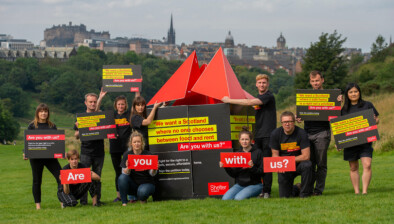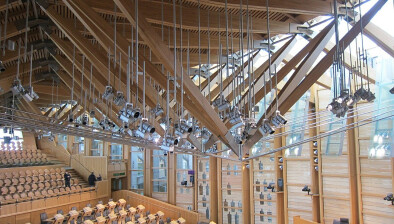Scottish Government welcomes 15% increase of new housing supply
Housing minister Kevin Stewart has welcomed a 15% increase in Scotland’s supply of new housing but has warned that a no-deal Brexit could have a damaging effect on future growth.

Kevin Stewart MSP
More than 22,000 homes have become available in the past year - nearly 3,000 more homes than the previous year.
This is the sixth consecutive annual increase in the total housing supply, the highest annual figure since 2008-09, and for the first time since 1980, local authority housing stock has also increased.
Mr Stewart said: “We want to ensure everyone has a warm affordable home and these figures show we are on target to reach delivering 50,000 affordable homes by 2021.
“However, I am deeply concerned that all our good work towards increasing Scotland’s housing supply could be significantly undermined by a no-deal Brexit.
“Private house builders are particularly vulnerable to the implications of Brexit. Construction material imports to the United Kingdom from European Union member states accounted for more than 60% of the total value of construction material imports to the United Kingdom in 2018.
“In addition, more than 7,000 EU nationals were employed in the Scottish construction sector in 2017. A no-deal Brexit poses significant risks to builders’ supply chains and the construction workforce in Scotland.
“Housing is yet another example of the deep damage that could be done to Scotland by a no-deal Brexit.”
Key findings from the Annual Housing statistics update:
New housing supply: New housing supply (new build, refurbishment and net conversions) increased by 15% between 2017-18 and 2018-19, from 19,320 to 22,273 new homes.
Housing supply figures include private-led and social sector new builds, as well as conversions and rehabilitations. Housing association new builds increased by 1,041 homes (33%) and private-led new builds increased by 2,679 homes (21%), whilst local authority new builds decreased by 51 homes (3%), refurbishments decreased by 642 homes (67%) and net conversions decreased by 74 homes (10%).
New house building: In 2018-19, 21,292 new build homes were completed in Scotland, an increase of 3,669 homes (21%) on the 17,623 completions in the previous year, the sixth consecutive annual increase and the highest annual number of completions since 2007-08. During the same time-period the number of homes started increased by 3,160 homes (16%) from 19,604 to 22,764.
Affordable housing: (As previously reported on 11 June 2019): In 2018-19, there were 9,554 units completed through all Affordable Housing Supply Programme (AHSP) activity, an increase of 994 units (12%) on the previous year. Approvals decreased by 547 units (5%) in the latest year to 11,130 in 2018-19, and starts increased by 303 units (3%) to reach 10,872. This activity represents the first three years in the target period to build 50,000 affordable homes, including 35,000 for social rent, over the five year period from 2016-17 to 2020-21.
Stock by tenure: As at 31st March 2018, there were an estimated 2.6 million dwellings in Scotland, an increase of 1% (20,000 dwellings) compared to 2017. The number of owner occupier households increased by an estimated 3%, and the number of housing association homes increased by 1%, whilst the number of local authority homes showed little change year on year (0%), and the number of dwellings rented privately (including with a job/business or rent-free) decreased by an estimated 6%.
Sales of local authority dwellings (Right to Buy): Sales of public authority dwellings (including local authorities with total stock transfers) fell by 96% between 2017-18 and 2018-19, to 76. This decrease follows the Right to Buy scheme closing to all new applicants in July 2016. It is expected that sales will continue to fall further in the next year as the number of applications remaining in the system falls closer to zero:
Local authority housing stock: At 31 March 2018, there were 315,625 local authority dwellings in Scotland, an increase of 1,192 units (0.4%) from the previous year, and the first annual increase in local authority stock seen in this time series since 1980.
Vacant stock: Local authorities reported 7,409 units of vacant stock at 31 March 2019, 269 units more than the 7,140 vacant units in the previous year. There were increases in units awaiting demolition (an increase of 141 units), and vacant normal letting stock (an increase of 171 units), with vacant units used as temporary accommodation for the homeless and vacant units in low demand areas showing similar totals to the previous year, and vacant units as part of a modernisation programme falling by 55 units.
Lettings: During 2018-19 there were 26,455 permanent lettings made, an increase of 789 units (3%) compared to 25,666 lettings in the previous year. There were 10,952 lets to homeless households in 2018-19, which equates to 41% of all permanent lets by local authorities.
Evictions: Eviction actions against local authority tenants resulted in 1,440 evictions or abandoned dwellings in 2018-19 (1,007 evictions, 433 abandoned dwellings). This is down 1%, or 20 actions of evictions or abandonments, on the 1,460 in the previous year.
Housing Lists: Household applications held on local authority or common housing register lists increased by 0.4% or 633 households to 158,439 at March 2019, the first annual increase since 2008, although the latest figure is 22% below the 202,235 applications recorded in 2008.
Scheme of assistance: There were 8,655 scheme of assistance grants paid to householders in 2018-19, 394 grants (4%) fewer than in 2017-18. Spend on scheme of assistance grants totalled £28.6 million, around £1.1 million less than in 2017-18. The majority of grants in 2018-19 were for disabled adaptions; 5,458 grants totalling £21.8 million.
Key findings from the Quarterly Housing statistics update to end June 2019
Latest quarterly social sector new build figures up to end June 2019 show that:
- between April and June 2019, 856 social sector new build homes were completed (19% less than the 1,060 completions in the same quarter in 2018), and 1,193 were started (5% more than the same quarter in the previous year). This brings the total completions for the 12 months to end June 2019 to 5,378 (a 13% increase on the 4,778 social sector homes completed in the previous year). Total starts over the 12 months to end June 2019 are now at 6,776 (2% more than the 6,611 started in the previous year)
Latest quarterly Affordable Housing Supply figures (new builds, rehabilitations and off-the-shelf purchases) up to end June 2019 show that:
- affordable housing supply completions have totalled 9,128, up 7% (633 homes) on the previous year. This includes increases in social rent completions (up by 23% or 1,189 homes) and affordable rent completions (up by 21% or 187 homes), and a decrease in affordable home ownership completions (down 30% or 743 homes)
- there were 10,844 affordable housing approvals over the year up to end June 2019, down by 9% or 1,088 homes compared to the previous year. This includes decreases in affordable rent approvals (down 55% or 1,403 homes) and affordable home ownership approvals (down 25% or 620 homes), with an increase in social rent approvals (up 14% or 935 homes)
- there were 10,370 affordable houses started in the year to end June 2019, down 2% or 246 homes compared to the previous year. This includes decreases in affordable rent starts (down by 43% or 792 homes), and affordable home ownership starts (down by 10% or 237 homes), but an increase in social rent starts (up 12% or 783 homes)








